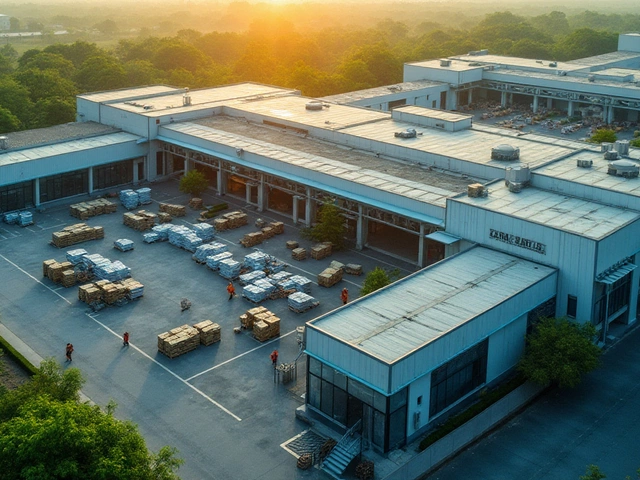Small scale production is fascinating because it combines the charm of handcrafted goods with the efficiency of larger operations. Picture this: fewer machines, more human touch, room for creativity, and, believe it or not, less waste. Sounds promising, right? Who doesn't love the idea of crafting something unique while being kind to our planet?
What you need to know first is that it all starts with a solid plan. Without one, even the best ideas can go astray. Planning for small scale production is like plotting your favorite storytelling arc. Each step needs clarity—like a map leading your way.
Now, materials. Finding the right stuff can be a bit of a treasure hunt. Working with limited quantities demands resourcefulness. Looking for discounted bulk buys? Repurposing materials? The options are as endless as they are exciting!
- Understanding Small Scale Production
- The Role of Planning and Strategy
- Sourcing Materials Efficiently
- Managing Labor and Operations
- Benefits of Small Scale Production
- Challenges and How to Overcome Them
Understanding Small Scale Production
Dive into small scale production and you’ll notice it bridges a fine gap between handcrafted uniqueness and mass-produced uniformity. But what does that really mean? Well, in simple terms, it means producing goods at a scale that’s larger than a one-person operation but way less than a sprawling factory churning out thousands of units per day.
The beauty of this method is the flexibility it offers. You’re not tied to massive production lines, so you can switch things up more easily. Have a new idea or a customer request? It’s usually much faster to bring those to life in a small-scale setting.
The Scale and Scope
Small scale manufacturing is often seen as a sweet spot for innovation. You have enough resources to experiment without the gigantic overheads that come with big factories. Imagine a small bakery that decides to introduce a new line of gluten-free bread based on customer feedback—much easier to test here than in a mega-brand setting.
The Human Touch
This isn’t just about products; it's about the people behind them. A smaller team often means more personal connections and a sharper focus on quality. Every person involved becomes critical to the success of the operation. This setup fosters not only strong teamwork but often results in high-quality outputs.
Unlike large operations, where every second saved counts, small scale production emphasizes precision and care. It's about finding that balance—producing enough to meet demand but not too much that it leads to wastage.
The Efficiency Factor
Speaking of waste, another key advantage of small scale setups is their efficiency. You tend to be more mindful of resources and waste, often leading to sustainable practices. Imagine a small clothing line that repurposes fabric remnants to create accessories—good for the environment and great for variety!
Getting Your Bearings
If you're considering diving into small scale manufacturing, a helpful tip is to start small—literally. Begin with a manageable product range that allows you to refine your processes without overwhelming your resources. As you gain confidence and traction, scale up strategically.
Small scale production is a perfect blend of creativity and practicality. It allows businesses to keep close to their customers, respond quickly to trends, and make a mark without the impersonal feel of large-scale operations. Perfect for those who want to make a big impact with a smaller footprint.
The Role of Planning and Strategy
In the world of small scale production, planning is everything. Think of it as the backbone of your operation. Without a strategic plan, even the best machines and materials won’t save you from chaos.
So, where do you start? Start with defining what you want to make and more importantly, who you’re making it for. Understanding your market can be a game-changer. It allows you to tailor not just the product, but the whole process to fit your target audience. It's like cooking for someone with a refined palate—precision matters.
The Importance of Flexibility
One of the big perks of running a small scale production is the flexibility it offers. Unlike larger factories, small operations can pivot and adapt quickly. This means you can experiment, try new things, and adjust based on what works best. Quick tweaks can make a significant difference.
Setting Goals: The SMART Way
And don’t forget about goals. Ever heard of SMART goals? It stands for Specific, Measurable, Achievable, Relevant, and Time-bound. These play a big role because vague goals only offer vague results. Specific goals guide daily operations and ensure everyone’s on the same page.
- Specific: Outline clear, concise targets.
- Measurable: Use numbers or milestones to track progress.
- Achievable: Set goals that are challenging but doable.
- Relevant: Ensure they align with your overall strategy.
- Time-bound: Set deadlines to keep things on track.
Budget Like a Boss
Lastly, let’s talk numbers. Budgeting is a critical part of your strategy. Paying attention to every cent can save you plenty of headaches down the road. Work efficiently within a budget, making every dollar count in the production process. And remember, cutting costs doesn’t mean cutting corners.
| Planning Aspect | Key Action |
|---|---|
| Market Analysis | Define your target audience |
| Flexibility | Adapt processes quickly |
| Goal Setting | Use SMART criteria |
| Budgeting | Stay within limits |
So, roll up your sleeves, lay down that plan, and watch how it transforms your small scale production dream into an efficient reality.
Sourcing Materials Efficiently
If there's one golden rule in small scale production, it's mastering the art of sourcing materials. Seriously, getting this right can make or break your operations. The key is finding quality without breaking the bank.
Know Your Needs
First things first, understand what materials you need. Make a list of everything required for production, right from the essentials down to the smallest component. This list will guide every sourcing decision.
Explore Local Markets
Local markets can be a treasure trove for small manufacturers. They often offer materials at lower costs compared to larger suppliers, and support local businesses, which is always a plus. Plus, you save on shipping costs – who doesn't like saving a bit of cash?
Build Relationships with Suppliers
Establishing good relationships with suppliers can lead to better deals and priority service. Suppliers might offer bulk discounts or notify you first about clearances. A little networking goes a long way.
Consider Sustainable Options
With growing environmental awareness, many small businesses are leaning towards eco-friendly materials. These not only help in positioning your brand as conscious but often cater to a niche market that's willing to pay a premium.
| Material | Cost-Effectiveness | Eco-Friendly |
|---|---|---|
| Recycled Aluminum | Medium | Yes |
| Bamboo | High | Yes |
| Organic Cotton | Low | Yes |
Leverage Online Platforms
Platforms like Alibaba or independent vendor sites open up a world of possibilities. You’ll find a wide range of quality and price, letting you pick what aligns with your budget and requirements. Just remember to vet your suppliers to avoid pitfalls.
Stay Updated
The market doesn't stay still. Follow trends, keep an eye on new materials or tech that could enhance your products. Sometimes, an innovation in materials can give you a significant edge.
In small scale production, efficient sourcing isn't just about getting the cheapest stuff—it's about value. Think smart, source smarter.

Managing Labor and Operations
Diving into small scale production, managing labor and operations can be a bit like coordinating a neighborhood potluck—everyone's got a role, and getting it right is crucial for success. In smaller settings, every team member often wears multiple hats. The flexibility here is a double-edged sword—it encourages creativity but demands clear communication and coordination.
First off, know your team. Identify their strengths and areas where they can shine. Are they better at hands-on tasks or the strategic planning side? Play to these strengths to keep the operations running smooth. And remember, investing in training boosts not just skills but morale too.
Streamlining Processes
Efficiency is king. Even in small businesses, time is money. Establish routines or standard operating procedures (SOPs) to minimize downtime and confusion. Consider using tools like Kanban boards or digital task managers to keep everyone on track.
- Weekly meetings keep everyone on the same page.
- Use checklists to ensure consistent quality.
- Encourage team input on improving processes.
Flexible Workforce
Be open to part-time workers or freelancers. They can offer the flexibility needed during different production phases. This approach also allows you to scale up or down without long-term commitments.
Keeping operations lean with these methods can lead to impressive results. According to a recent survey, 60% of small businesses that adapted flexible labor practices reported increased efficiencies.
Monitoring Progress
Lastly, track everything. From material costs to production time, data is your friend. Keep an eye on key performance indicators (KPIs) to ensure you're on the right path. And speaking of records, digital solutions can save your sanity!
Remember, managing labor and operations isn't just about keeping the wheels turning. It's about creating a workplace that encourages success and innovation. With the right strategies, even the smallest operations can do big things.
Benefits of Small Scale Production
When we talk about small scale production, we're really looking at a setup that promises a bunch of perks. Why work small? Well, imagine having the flexibility to switch gears fast, cut down on waste, and even personalize products to meet customer dreams.
Flexibility and Adaptability
One of the biggest benefits of small scale operations is adaptability. If trends shift or a new fad emerges, smaller setups can pivot without a sweat. Jane Doe, a small business expert, hit the nail on the head when she said,
"Small scale production allows businesses to be nimble—agile enough to change course and align with market needs swiftly."
Quality and Personalization
Then there’s quality. Smaller means more control. This often results in products that are not only high in quality but can also be personalized. Who wouldn't want something tailor-made?
Reduced Waste and Environmental Impact
Let’s chat sustainability. By producing only what’s needed, waste drops dramatically. This is a massive win for Mother Earth. Plus, small scale manufacturing often uses local materials, supporting nearby communities while reducing the carbon footprint of transporting goods across continents.
Cost Efficiency
You might think keeping things small would push costs up—it’s actually the opposite. With fewer resources tied up in equipment or wasted inventory, production costs can be kept in check. For those keeping an eye on the purse strings, this is solid gold.
| Benefit | Why It Matters |
|---|---|
| Flexibility | Adapt to trends quickly without major overhaul. |
| Quality | Enhanced control over product specifications. |
| Sustainability | Less waste and support for local materials. |
| Cost Efficiency | Lower overhead and reduced inventory costs. |
Challenges and How to Overcome Them
Tackling small scale production isn't all rainbows and butterflies. There are hurdles, but fear not. With the right approach, you can turn these obstacles into stepping stones.
Limited Resources
When producing on a smaller scale, chances are you're working with fewer resources. This means less manpower, fewer machines, and limited funds. It's crucial to maximize what you have. Prioritize spending—focus on tools and materials that are essential for your product. Need to stretch your budget? Consider collaborating with other small businesses to share costs, especially when buying materials in bulk.
Scaling Up
One of the trickiest parts is knowing when and how to scale up. Small scale operations often start with small batches to maintain quality. But as demand grows, you might need to ramp up. It's a delicate balance. Try expanding gradually, ensuring your quality doesn't dip. Maybe start with adding new products instead of increasing the quantity of one. A flexible production plan can help you avoid bottlenecks.
Maintaining Quality
Your products' charm lies in their quality and uniqueness—let's not lose that! As production increases, keep a close eye on quality control. Set up regular quality checks and involve your team in finding ways to maintain those high standards. Encourage feedback from customers too—it’s invaluable for staying on track.
| Challenge | Solution |
|---|---|
| Limited Resources | Prioritize spending; collaborate for bulk purchases |
| Scaling Up | Expand gradually with a flexible plan |
| Maintaining Quality | Implement regular quality checks |
Time Management
Time flies when you're deep in production. Organizing your schedule and sticking to it can prevent burnout. Break down tasks into daily goals and avoid overloading yourself. Sometimes, stepping back and reassessing priorities can do wonders. Keep communication open with your team and consider tools to help manage tasks effectively.
In a nutshell, small scale production comes with its set of hiccups. But with strategic planning and a proactive approach, you can turn these trials into triumphs. Remember, every challenge is an opportunity to innovate and grow!







Write a comment